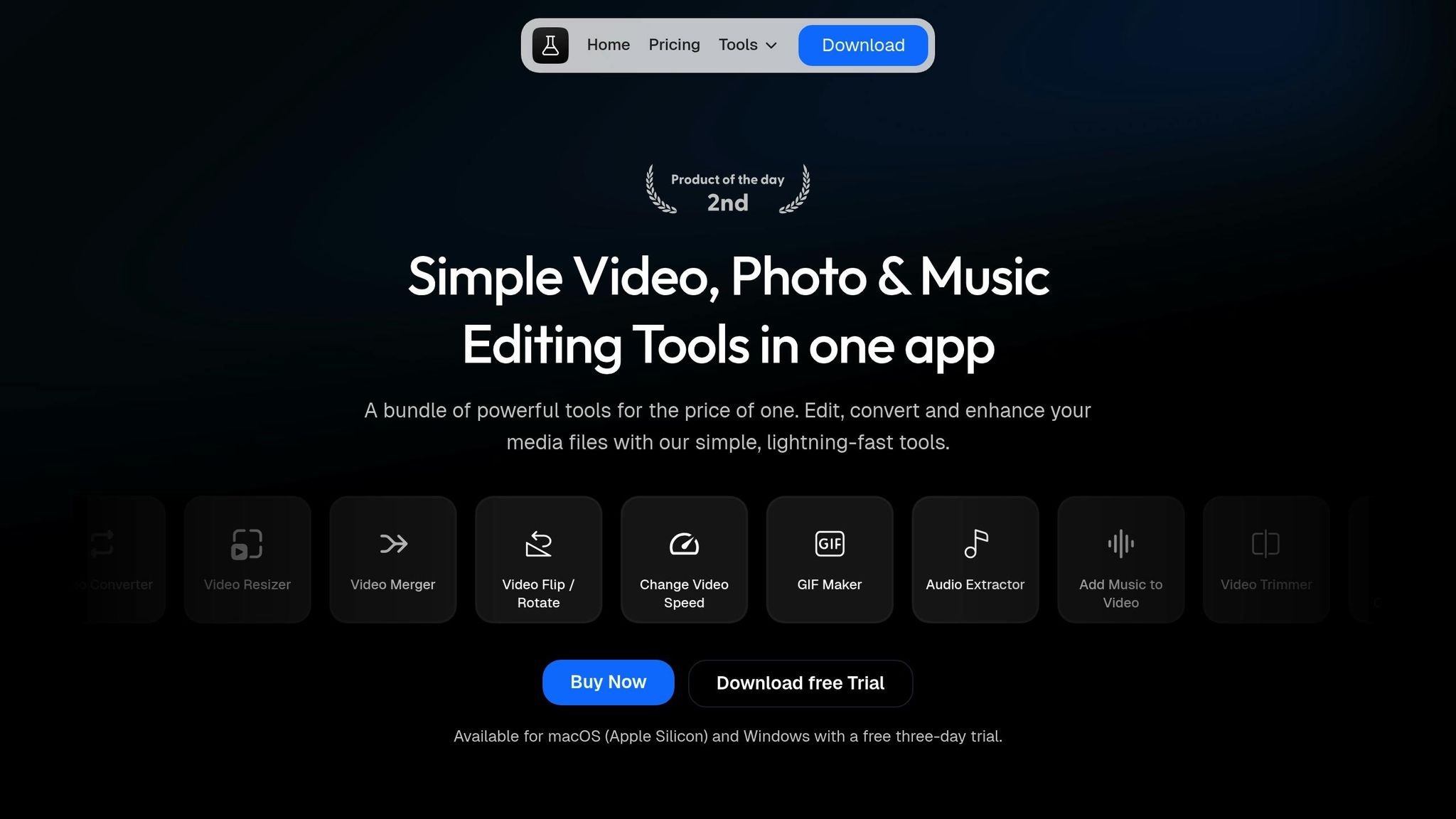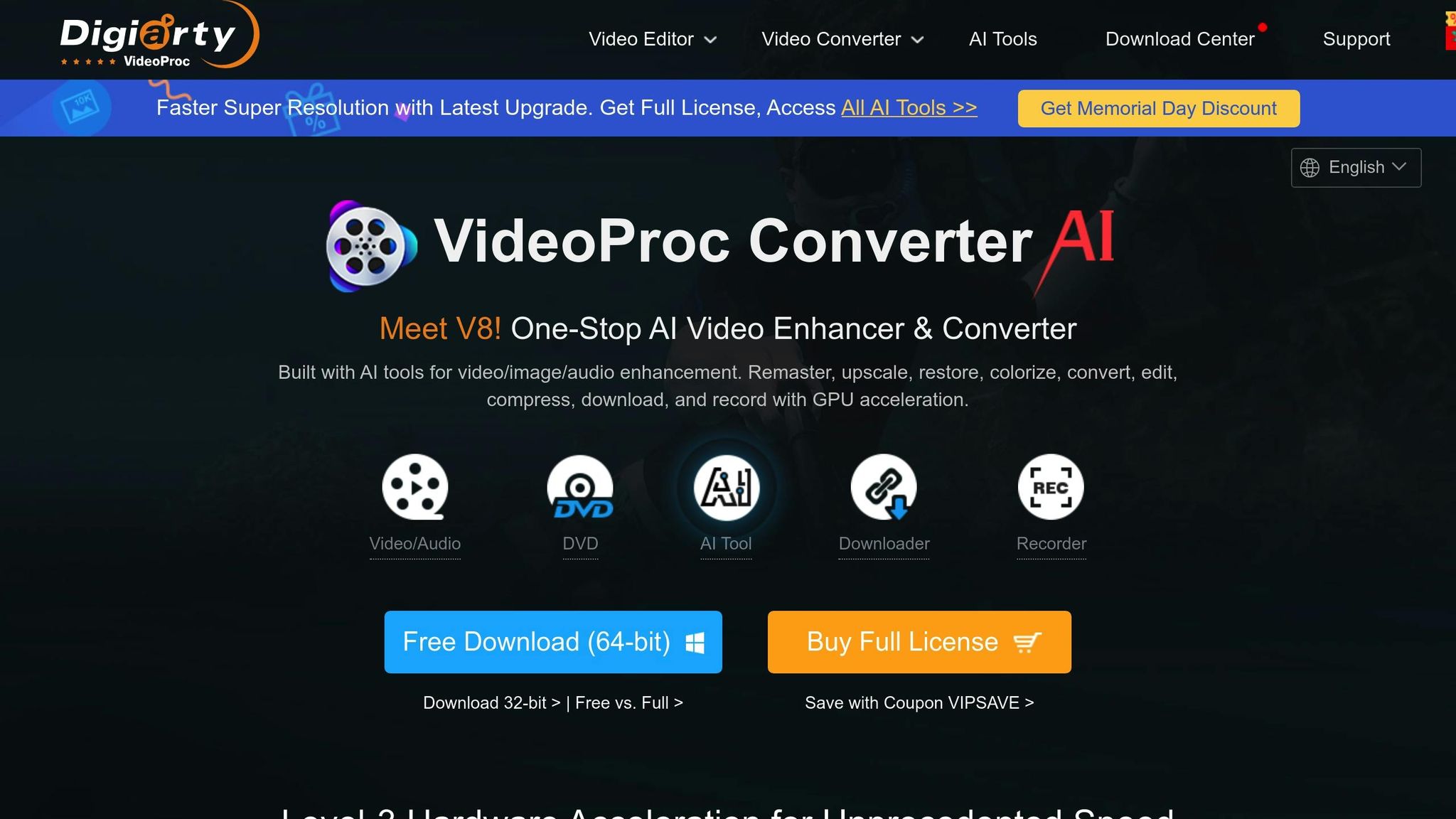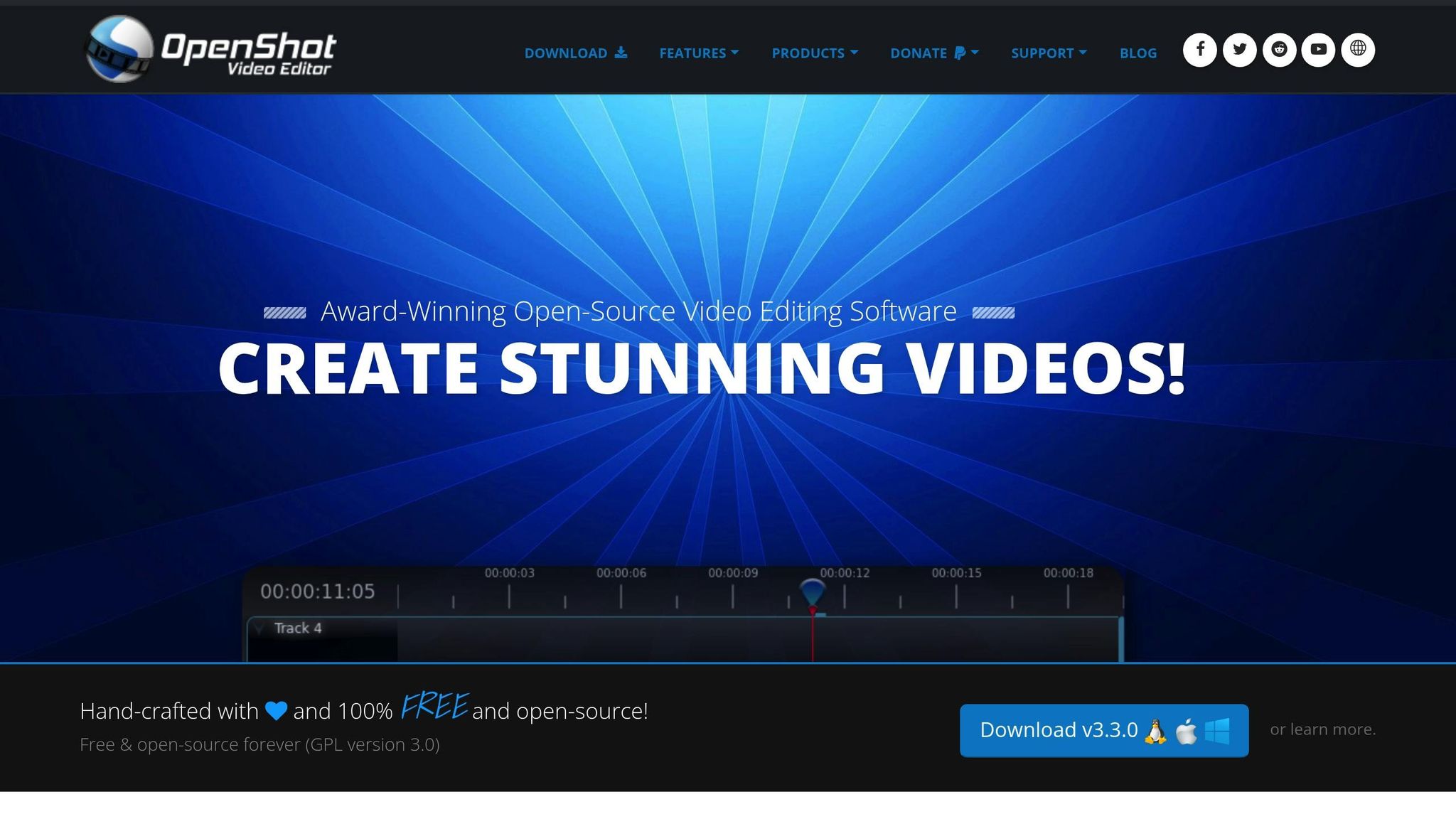
Slow Computer? 5 Lightweight Editing Tools to Try
Struggling with a slow computer for editing? You don’t need a hardware upgrade to get things done. Lightweight editing tools are designed to work smoothly on older machines, letting you edit videos, photos, and audio without the frustration of crashes or lag.
Key Takeaways:
- Save Resources: These tools use less CPU, RAM, and storage.
- Stay Productive: Perform essential edits like trimming, resizing, or compressing files efficiently.
- Affordable Options: Many tools are free or budget-friendly.
Here are five great options:
-
Pimosa: All-in-one tool for video, image, and audio editing. Works offline and handles batch processing.
Price: $19/year or $29 lifetime. -
VideoProc Converter AI: AI-powered video editor with GPU acceleration for faster processing.
Price: Free trial available, paid plans start at $29.95. -
Icecream Video Editor: Simple video editor with low system requirements and no watermarks on short videos.
Price: Free and paid versions. -
Shotcut: Free, open-source editor with professional features like proxy editing for smoother performance.
Price: Free. -
OpenShot: Free editor with unlimited tracks, 3D title creation, and wide format support.
Price: Free.
Quick Comparison Table:
| Tool | Minimum RAM | Price | Key Features | Offline Editing |
|---|---|---|---|---|
| Pimosa | 4 GB | $19/year | Batch processing, multi-format | Yes |
| VideoProc AI | 4 GB | $29.95/year | AI tools, GPU acceleration | Yes |
| Icecream Editor | 2 GB | Free/$ | No watermarks on short videos | Yes |
| Shotcut | 4 GB | Free | Proxy editing, open-source | Yes |
| OpenShot | 4 GB | Free | Unlimited tracks, 3D titles | Yes |
Lightweight tools like these can make editing hassle-free, even on slower computers. Pair them with simple system tweaks - like clearing temporary files or closing background apps - to maximize performance.
Best FREE Video Editing Software for SLOW COMPUTERS
1. Pimosa

Pimosa is a versatile media editing tool that combines video, image, and audio editing into a single, lightweight application. Developed by Ansh Rathod, this software is particularly suited for older computers, offering a streamlined solution for various media tasks.
System Requirements
Pimosa is compatible with both Windows and macOS, and it’s designed to run smoothly on systems with minimal hardware capabilities. Since all files are processed locally, there’s no need for a constant internet connection, ensuring your media remains private and secure throughout the editing process.
Core Features
Pimosa packs a range of editing tools into one simple interface, covering video, image, and audio editing needs:
- Video Editing: Compress files, convert formats (MP4, AVI, MKV), resize, merge, adjust speed, and extract audio.
- Image Editing: Compress images, convert formats (JPG, PNG, BMP), resize, and crop.
- Audio Editing: Convert formats (MP3, WAV, AAC), edit metadata, and create waveforms.
The batch processing feature allows you to handle multiple files at once, making it easier to manage large media libraries. Additionally, the app includes built-in players for video and audio, as well as an image viewer, so you can preview your work without switching between different programs.
Ideal Use Case
Pimosa is perfect for those who need an efficient and straightforward media editing tool. It’s a great fit for content creators and small business owners who value quick media conversion and compression. The user-friendly interface ensures accessibility for beginners while still meeting the needs of seasoned users.
"Love how Pimosa brings together so many useful tools in one app! Definitely saves a ton of time when you can quickly compress, convert, and even create GIFs all in one place. The simplicity is key, perfect for someone (including me, as a designer myself) who just needs to get things done without all the complexity."
– Shivam Singh, Product & Growth Lead, Shram
Resource Efficiency
Pimosa’s lightweight design prioritizes speed and simplicity. By integrating multiple editing functions into one program, it minimizes memory usage and avoids the resource drain caused by running several specialized applications. Over 500 users have praised its efficiency and ease of use, making it a reliable choice for media editing tasks.
Pricing: $19/year. Lifetime options are available at $29 for a single device or $49 for two devices. A free three-day trial is included. Up next, discover another lightweight tool designed for efficient video processing.
2. VideoProc Converter AI

VideoProc Converter AI is a lightweight video editing solution designed to perform efficiently, even on older computers. With a user base exceeding 4.6 million people, this tool delivers impressive results without straining system resources. Let’s dive into its system requirements and standout features.
System Requirements
VideoProc Converter AI is built to run on less powerful hardware. The minimum setup includes a 1 GHz Intel® or AMD® processor, 1 GB of RAM (though 2 GB is recommended), and just 200 MB of available storage for installation. It also supports graphics acceleration through NVIDIA (GT 630+), Intel HD Graphics 2000+, AMD Radeon HD 7700+, and various Apple silicon chips.
Core Features
This software harnesses Level-3 Hardware Acceleration, which utilizes Intel QSV, NVIDIA CUDA/NVENC, AMD GPUs, and Apple silicon chips to shift processing tasks away from the CPU. Its AI-driven tools are designed to improve video quality, handle format conversions, compress large files, and perform quick edits. With support for 370 input codecs and over 420 output formats, it offers exceptional versatility. Key features include:
- Video upscaling
- Stabilization for shaky footage
- Noise removal
- Fisheye correction
"Level-3 GPU acceleration makes VideoProc Converter the number one video editor with up to 47x faster encoding while preserving video and audio quality." - Dennis Faas, Author
Ideal Use Case
This tool is perfect for refining home videos, stabilizing unsteady recordings, digitizing DVDs, and ensuring smooth playback on mobile devices. Its AI capabilities enhance video clarity, making it especially useful for content creators looking to polish older footage for platforms like YouTube and social media. Additionally, it’s an excellent choice for creating screen recordings and tutorials.
Resource Efficiency
VideoProc Converter AI sets itself apart with its resource-friendly design. It consumes just 2% of CPU power, processes videos up to 47× faster, and can shrink file sizes by as much as 90%. For users on slower systems, the software performs best when hardware acceleration is enabled, the "Real Smooth" model is selected, H.264 is chosen over H.265, and quality settings are adjusted to "Medium" or "High."
With a 4.1/5-star rating on both Trustpilot and GetApp, it’s clear that VideoProc Converter AI has earned its place as a favorite among users.
3. Icecream Video Editor

If you're looking for a video editing tool that runs smoothly on older or slower systems, Icecream Video Editor is worth considering. With a 5/5 rating on G2 and 4.4/5 on Capterra, it’s recognized for making video editing accessible to users with limited hardware capabilities.
System Requirements
Icecream Video Editor is designed to perform well even on modest setups. The minimum requirements include a processor from Intel, AMD, or similar running at 2.66 GHz, 4 GB of RAM (though 16 GB is recommended for larger projects), and a display resolution of 1280x720. It’s compatible with Windows 7 through Windows 11. Depending on your project size, the software requires between 100 MB and 5 GB of disk space.
Core Features
This lightweight editor packs plenty of tools for basic and intermediate video projects. You can trim, cut, and merge clips with ease, while also adding smooth transitions and visual effects that won’t bog down your system.
Some of its standout features include:
- Video rotation and speed adjustments
- Blur effects for creative storytelling
- Audio customization with volume control, effects, and fade transitions
- Options to insert text overlays and additional audio tracks
One bonus: the free version doesn’t add watermarks to short videos.
Ideal Use Case
Icecream Video Editor is perfect for beginners or those working on simple projects. Its intuitive interface makes it easy to navigate, even for users with minimal technical knowledge. Whether you're editing social media clips, creating basic YouTube content, compiling family videos, or producing simple promotional material, this tool gets the job done without unnecessary complexity.
Resource Efficiency
This software shines when it comes to balancing performance with functionality on lower-end computers. To get the best results on slower systems, consider lowering your video resolution to 720p or 1080p, closing unnecessary background apps, and working with optimized formats like MP4 using the H.264 codec. Editing in smaller sections and limiting heavy effects can also help. While 4 GB of RAM is sufficient for basic tasks, upgrading to 16 GB can make a noticeable difference when dealing with larger or more complex projects.
sbb-itb-60ba97a
4. Shotcut

Shotcut is a free, open-source video editor that’s built to perform well even on slower computers. Despite being lightweight, it offers a range of professional-grade features. With ratings like 4/5 stars from TechRadar, 3.5/5 stars from PCMag, and 4.5/5 stars on Capterra, it’s clear that Shotcut delivers quality video editing without the need for expensive software.
System Requirements
Shotcut’s system requirements are refreshingly modest. It needs just 500MB of disk space for installation and works on 64-bit Windows 10 (build 1809) through Windows 11, macOS 12 through 15, or 64-bit Linux with glibc 2.31 or higher.
For smooth performance, the hardware requirements vary based on your project’s resolution:
- SD video: A single 2 GHz core and 4 GB of RAM.
- HD video: 4 cores and 8 GB of RAM.
- 4K video: 8 cores and 16 GB of RAM.
A graphics card supporting OpenGL 2.0 (Linux) or Direct3D 11 (Windows) is also recommended.
Core Features
What sets Shotcut apart is its ability to function efficiently on slower systems. Its codec-independent design doesn’t rely on your system’s codecs, and its integration with FFmpeg allows it to support hundreds of audio and video formats.
The editor includes native timeline editing, meaning you can skip the time-consuming import process. You can even combine clips with different resolutions and frame rates within a single project. Another bonus? Shotcut can run directly from an external drive as a portable app, making it easy to use across multiple devices.
For users handling high-resolution footage, the low-resolution proxy editing feature is a game-changer. It speeds up playback and reduces the strain on your system during the editing process. These features make Shotcut a reliable and practical choice for a variety of tasks.
Ideal Use Case
Shotcut is a versatile tool for creators of all experience levels. Whether you’re editing YouTube videos, crafting social media content, or working on personal projects, this software has you covered. It’s completely free to use, with no watermarks, ads, or restrictions on video length or export resolution - even for 4K projects. Plus, its customizable interface lets you tailor the workspace to fit your editing style.
Resource Efficiency
Shotcut’s lightweight design minimizes the risk of crashes compared to heavier video editors. To get the best performance on slower systems, consider the following tips:
- Convert raw footage to MP4 using the H.264 codec before editing.
- Use proxy files or draft-quality previews to lower the video resolution to 720p or 1080p.
- Close unnecessary background apps and reduce the preview resolution.
- Avoid using too many real-time effects or overly complex transitions.
- Break larger projects into smaller sections for easier handling.
These strategies can help you make the most of Shotcut, especially on less powerful machines.
5. OpenShot

OpenShot is a free, open-source video editing tool designed to perform smoothly even on older or less powerful computers. It boasts a 4.3/5 star rating on Software Advice, with 174 reviews highlighting its user-friendly design, solid functionality, and affordability.
System Requirements
OpenShot is compatible with a wide range of systems. To run it, you'll need a 64-bit operating system - Windows 8/8.1/10/11, macOS 10.15 or later, most Linux distributions, or ChromeOS 83 or later. The hardware requirements include a 64-bit x86_64 multi-core processor (minimum two cores, but six or more are recommended) with a clock speed of at least 2.7 GHz turbo (3.4 GHz recommended). You'll also need at least 4 GB of RAM (16 GB recommended for better performance), 1 GB of installation space, and roughly 500 GB of free storage for handling larger video projects.
Core Features
OpenShot’s feature set is both versatile and powerful. It uses the FFmpeg library, allowing support for nearly every video, audio, and image format. The software provides unlimited tracks and layers, along with a timeline editor that includes drag-and-drop functionality, zooming, scrolling, and snapping for precise adjustments. Editing tools let you trim, scale, rotate, and transform clips with ease.
Additional features include real-time previews, over 70 video profiles and presets (like YouTube HD), frame-accurate editing, and time re-mapping for speed adjustments. OpenShot also integrates with Blender for creating 3D animated titles and supports vector file editing (SVG) for professional-grade graphics. To enhance audio, it comes with mixing and waveform editing tools.
Ideal Use Cases
OpenShot is a great fit for educational, personal, and organizational projects. Whether you’re creating instructional videos, internal communications, personal edits, or social media content, OpenShot handles tasks like adding text, music, transitions, effects, and even emojis with ease.
Resource Efficiency
Built with efficiency in mind, OpenShot is available on Windows, macOS, Linux, and ChromeOS without any licensing fees. It’s particularly well-suited for slower computers - just work with lower-resolution or proxy files to keep things running smoothly. The lightweight design minimizes system strain, while support for over 100 languages and GPL v3 licensing ensures accessibility for users worldwide.
Tool Comparison Table
The table below highlights the essential system requirements and performance features of various video editing tools, making it easier to compare their capabilities at a glance.
| Tool | Minimum RAM | Operating System | Storage Space | Offline Capability | Key Performance Features |
|---|---|---|---|---|---|
| Pimosa | 4 GB | Windows, macOS, Linux | 500 MB | Full offline editing | Local file processing, batch operations, built-in players |
| VideoProc Converter AI | 4 GB | Windows 7+, macOS 10.6+ | 1.2 GB | Complete offline functionality | Hardware acceleration, GPU optimization |
| Icecream Video Editor | 2 GB | Windows 7/8/10/11 | 85 MB | Full offline editing | Lightweight design, optimized rendering |
| Shotcut | 4 GB | Windows, macOS, Linux | 200 MB | Complete offline capability | Multi-format support, proxy editing |
| OpenShot | 4 GB (16 GB recommended) | Windows 8+, macOS 10.15+, Linux | 1 GB + additional project space (approximately 500 GB for larger projects) | Full offline editing | FFmpeg integration, unlimited tracks |
If you're working with older or less powerful machines, Icecream Video Editor stands out with its low RAM requirement and minimal storage needs, making it a practical choice. For users seeking a more feature-rich option without sacrificing efficiency, Pimosa offers a solid balance of performance and usability. On the other hand, OpenShot caters to advanced users with robust features like unlimited tracks and FFmpeg integration but demands higher system resources, especially for larger projects.
Storage needs vary significantly across these tools. While Icecream Video Editor requires just 85 MB, VideoProc Converter AI and OpenShot need considerably more space, particularly when working on large-scale projects.
To get the best performance from any of these tools, consider reducing preview quality during editing, switching to an SSD, or dedicating your primary drive to applications. These steps can help ensure smoother workflows even on systems with limited hardware capabilities.
Conclusion
Just because you're working with a slow computer doesn't mean you have to give up on your editing projects or endure constant frustration. Lightweight editing tools are designed to perform well even on older hardware, offering a practical solution for smoother workflows without the need for a major hardware upgrade.
Beyond selecting the right software, there are simple yet effective steps you can take to improve performance. Regular system maintenance, like clearing temporary files and managing background processes, can make a noticeable difference. If you're open to minor hardware upgrades, adding an SSD or increasing your RAM can significantly enhance your editing experience, especially for memory-intensive tasks like video editing.
Pairing lightweight tools with basic system adjustments - such as tweaking visual effects settings or ensuring your system stays updated - can create a more responsive editing environment. These small changes work together to maximize your computer's capabilities without pushing it beyond its limits.
The key is finding the right balance between efficient software and smart system optimizations. With the strategies and tools discussed in this guide, you can achieve a smoother editing workflow without breaking the bank on new hardware. Editing on a slower computer doesn't have to be a struggle; it just takes the right approach to make the most of what you have.
FAQs
How do I choose the best lightweight editing tool for my needs?
To choose the best lightweight editing tool, start by determining the type of media you’ll be working with - whether it’s video, images, or audio. This will help narrow down your options. Next, check the tool’s system requirements to make sure it runs smoothly on your computer. These tools are built to work well on less powerful machines, making them a great choice for older or slower systems.
After that, focus on the features you need. Prioritize tools with a straightforward interface, support for your preferred file formats, and the specific functions that align with your editing goals. For instance, if you’re looking for quick, hassle-free edits, go for a tool that’s known for being user-friendly and efficient. This way, you can enjoy a smooth editing process without needing to upgrade your hardware.
How can I optimize my slow computer to run lightweight editing tools more efficiently?
To get better performance from lightweight editing tools on a slower computer, try these simple tips:
- Clear out disk space: Delete unnecessary files and remove unused programs regularly. This ensures your computer has enough storage for editing tasks to run smoothly.
- Reduce startup programs: Stop non-essential apps from launching automatically when you start your computer. This frees up system resources and can make a noticeable difference in speed.
- Optimize power settings: Switch your power plan to "High Performance" to get the most out of your computer during editing sessions.
- Use GPU acceleration: If your editing software supports it, enabling GPU acceleration can significantly boost rendering and playback speeds.
These adjustments can help you get more out of your current setup, making editing smoother without needing to invest in new hardware.
What are the potential downsides of using lightweight editing tools compared to more advanced software?
Lightweight editing tools are built to perform smoothly on older or less powerful computers, making them a solid choice for simple tasks. However, they often come with limitations. Features like high-resolution video editing, intricate effects, or deep customization options are usually absent, which can restrict creativity when tackling more complex projects.
Another downside is their performance with larger files or demanding tasks. These tools can sometimes lag or even crash under pressure. While they are easy to use and perfect for basic editing, they might fall short for professionals who need more advanced and robust editing capabilities.